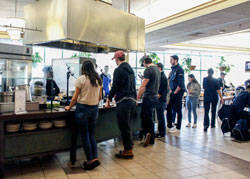Over the summer the interior of the Magill Commons Dining Hall was heavily renovated, changing both the look of the dining area and the layout of the food service stations. Favorite stations remained while new ones, including a small diner, were added.
The dining hall now looks similar to the interior of the Rebecca Stafford Student Center (RSSC). White picnic tables line up next to the windows, booths line the inner walls, and the wooden chairs at the inner tables have been changed into multicolored metal ones. The seating along the back wall has been changed into a bar where students can sit. Many paintings have been removed, as well as overhanging plants, and the walls have been painted to give the dining area a fresh, modern feel. The serving area is now more open and vibrant, and the space now feels less cluttered and claustrophobic.
The renovations took about four months, according to Mary Anne Nagy, Vice President for Student Life and Leadership Engagement. Renovations began on May 9 and were completed by the time students returned for the 2016/2017 school year. According to Nagy, there are still some minor pieces left to complete, such as the addition of a few more banquettes in the south end of the dining hall on the east side.
While there are no final bills in for the cost of the renovations, Nagy estimates that the project will come in at just under three million dollars. The two most expensive pieces of the renovation were the diner and the expansion of the center island, due to the need for new plumbing, electrical, and gas lines, and the creation or change of various pieces of infrastructure. “They were the most expensive, but they are the most important parts of the facility,” said Nagy. “I think the diner will be a huge hit with students. I think the other thing that seems to have been one of the biggest hits is the hot plate station, where students can make their own omelet; they can sautee their own vegetables and proteins and pasta and sauce; they can make their own meal. It’s another way for students to control what they consume,” added Nagy.
Familiar favorite stations are still open and functioning, just with a renovated look, and the dining hall continues to have a variety of vegan, vegetarian, and gluten-free options for students. The food is still provided by Gourmet Dining Services. Some stations were slightly upgraded, such as the pizza station, which now uses a brick oven to make food.
New stations include a ‘make-your-own’ cooking station, where students can fill a frying pan with foods of their choice and cook it themselves. This adds a great deal of customization and choice to the dining hall, and students can really personalize their meals to their exact specifications. Another new station is an added-on diner, where students can order breakfast sandwiches and other items that were not previously available in the dining hall. The diner area also provides a seating area, which is slightly quieter and more secluded than the seating in the rest of the dining hall. There is also a bakery section available in the very front of the dining hall, before students even step into the seating area.
 The decision to do the renovations was made last year, when Monmouth University replaced Aramark with Gourmet Dining.
The decision to do the renovations was made last year, when Monmouth University replaced Aramark with Gourmet Dining.
“I think that in many aspects the dining hall has improved,” said junior theater student Chloe Meyer. “My favorite area is definitely the diner.”
“I think the renovations are great,” said junior English student Malia Padalino. “I like the cooking station and the new look. The diner is also a great add-on. The only thing that lacks is the amount of seating – I feel like there are less seats. Also, I’m not a fan of the picnic benches because they don’t have back support. But overall, I’m glad they renovated it!”
“I think that they are good and it’s a better layout than what it was before,” said junior chemistry student Lauren Lucia. “I feel like it’s nicer, the seats in the booths are actually connected, unlike on the booths last year, where the seats actually could pop out. Everything’s obviously newer, and it all looks a lot cleaner.”
“As we went through the competitive bid process, it was clear that the residential dining facility needed to undergo a massive renovation and refurbishment. When we made the decision to go with Gourmet we knew we were going to have a renovation. We had not really touched the dining hall for ten years, inside, and before that it was even earlier along,” said Nagy. “We knew that the Gourmet program was very different, and that in order to deliver the program of food they wanted to prepare, a renovation to the facility was necessary. Last year we tried to change the food, but we were changing the food in the old structure. Now you have the changed food and the new structure, all coming together, so I think it makes a lot more sense.”
Nagy also explained that one of the most important changes that had been made was the fact that more options were available for students, and there was more customization to be found in various stations. “I think students clearly need to get into the facility,” she said. “I think if you have a residential meal plan you’re there every day; I would encourage every student to get some level of a plan… I think what you’re really going to see more of is the food being prepared in front of you. It’s not behind walls anymore. You’re going to see the baker make dough for the cookies that are going on the tray that she’s putting in the oven.”
“It takes the mystery out, and it shows the level of quality, You have a better sense that it’s fresh, and what its preparation is. I think it’s a pretty cool place,” Nagy added.
PHOTO TAKEN by Jamilah McMillan



